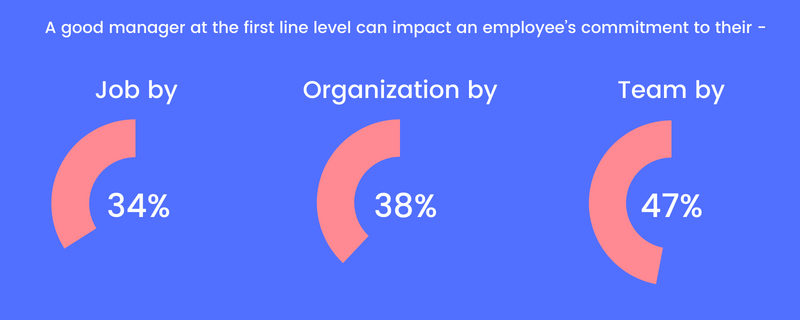We are all familiar, if not overexposed, to the term VUCA as a descriptor of today’s business environment. First line manager, in particular, are often at the forefront of navigating this uncertainty, as they play a crucial role in helping their teams survive and thrive in an environment that consistently causes unpredictable disruptions. To cope or deal with this environment, organizations are now wanting to build “agility” as a behavior with a scary sense of urgency! Several pundit’s in the market have touted agility and innovation to be the mantra to be change ready. However, as displayed in the recent Global Trends Study by Mercer (2017), only 4% of executives feel their organization is ‘change agile’.
Change readiness or agility needs to be practiced in the form of behaviors across levels within the organization. However, the realization that First Line Managers directly supervise up to 80% of the workforce, has shifted the focus on the role of leadership at the base of the organization driving agility. Companies that have employed bottom up leadership, empowering leaders who are at front lines, have become more competitive.
In the above infographic it is important to note that these employees are generally promoted to the First Line Manager position because of their high performance as individual contributors and are rarely equipped to be good managers. In fact, only 40% of first time managers make a smooth transition into this role.
In a recent report, Richard S. Wellins, Aviel Selkovits, and Debbie McGrath stated that with growing demands for agility, innovation, and efficiency, leading at the first line manager level has become even more challenging. First Line leaders are the most sought out, yet uninformed, ill-equipped, and under-utilized communication and behavior change vehicle of an organization.
Case Example of Developing First Line Managers
A leading software engineering company, through the use of an employee satisfaction survey, found a significant gap in the manager-team relationships, particularly in enabling the team to be flexible and agile in response to changing customer needs. This highlighted the need for enhanced first line manager training to better equip managers with the skills necessary for fostering such adaptability. Most managers in this organization has risen to their current leadership roles from within the organization, i.e. from being individual contributors to first time manager, leading a team of 6-20 members.
The company first validated the scores received on the employee satisfaction survey through a one-on-one interview with top management, as well as a reverse feedback score, emphasizing the responsibility of first line managers in shaping team dynamics and overall satisfaction. A customised 3-day workshop was designed to equip and train the managers through a phased developmental process. The managers also participated in a 2-day intensive workshop where the aim was to further enhance the group on additional management skills.
Through these workshops, the client was able to create a positive impact on developing leadership behaviors and skills, with a special focus to help manage change and changing customer needs as a team. Managing ambiguity with and through team members who have their own distinct styles, was one of the areas of impact. The modules to meet this need were contextualized to real situations that the First Line Managers were facing, aligning with the responsibility of first line managers to effectively lead their teams. As a result, the input they needed was more relevant, leading to a significant increase in the employee satisfaction scores for the participating managers.
The contextualization and applicability of the development validated the investment made by the organization.
There is an observable increase in the market in the effort spent on developing transitioning managers. For instance, the Bersin report suggests that there is a 30% increase in the budgets assigned to new manager development. However, the per-person budgets at this level are still half when compared with mid-managers. While organizations are viewing this as an emerging need, the investment being has not seen a comparative increase.
References:
- Bottom-Up Leadership: How Developing and Empowering First Line Leaders Can Restore Competitiveness. (2017). Retrieved from Harvard Business Review: https://www.uk.mercer.com/content/dam/mercer/attachments/private/uk-2017-how-to-develop-first-line-leaders-and-line-managers-report.pdf
- Be Better Than Average: The State of Frontline Leadership. (2013). Retrieved from DDI World: https://www.ddiworld.com/ddi/media/trend-research/bebetterthanaverage_tr_ddi.pdf
- Walking the walk: making front-line managers successful. (2014). Retrieved from BearingPoint Institute: https://www.bearingpoint.com/en/our-success/thought-leadership/walking-the-walk-making-front-line-managers-successful/








